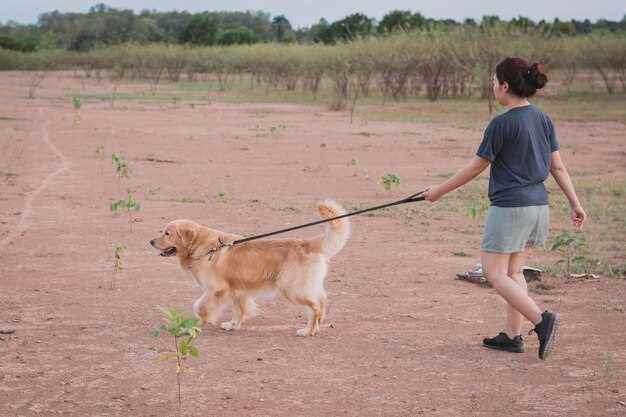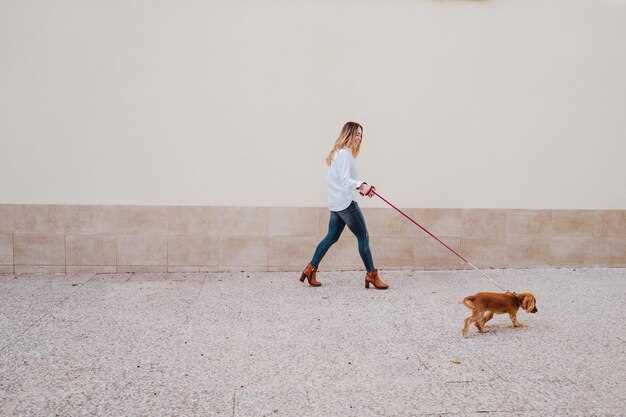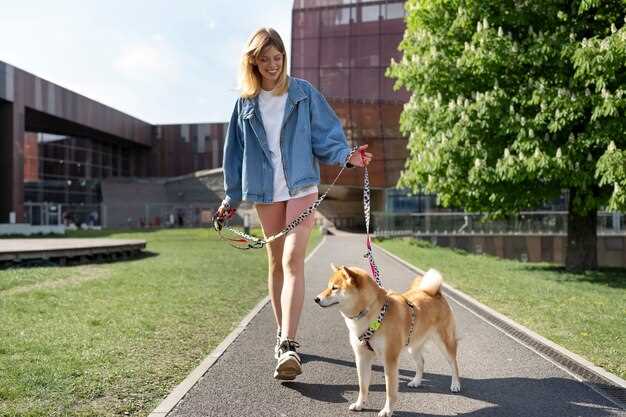Start by choosing the right equipment. A front-clip harness can make a significant difference in your dog’s ability to pull you along. Unlike traditional collars, the front-clip harness provides better control and diminishes the force of pulling.
Consistency is the key to success. Implement a strict stop-and-go technique, where you stop walking as soon as your dog starts pulling. This method teaches your pet that pulling will halt forward movement instead of speeding it up, reinforcing the idea that loose-leash walking is the preferred behavior.
Positive reinforcement plays a vital role. Always reward your dog for walking beside you without tension on the leash. Use treats or verbal praises to motivate and encourage your pet. Gradually decrease the frequency of treats as your dog improves, but continue to ensure verbal rewards remain a constant.
Practice makes perfect, and regular training sessions are essential. Aim for short, daily walks rather than sporadic long ones. This allows both you and your dog to build a habit without feeling overwhelmed. Also, varying your walking routes can prevent boredom and keep your dog’s attention on you.
Understanding the Causes of Pulling

Identify what motivates your dog to pull on the leash to effectively address the behavior. Curiosity often drives dogs to pull; the world is a fascinating place full of smells and sights that captivate their senses. Observing what specifically attracts your dog during walks will help in creating a strategy to manage pulling. If your dog yanks on the leash when seeing other animals or people, it’s likely due to excitement or the desire to socialize.
Unreasonable energy levels also play a significant role. High-energy breeds require ample exercise and mental stimulation. Ensure your dog receives sufficient physical activity before a walk to decrease the likelihood of strong pulling. Anxiety or fear can also contribute to leash pulling. A dog feeling threatened or anxious might try to rush back home or away from intimidating stimuli. Understand these triggers and gradually introduce your dog to them in a controlled manner, reinforcing calm behavior with positive reinforcement.
Training inconsistencies are another common cause. Dogs thrive on routine and clear expectations. Inconsistency in enforcing leash manners can confuse your pet and encourage pulling. Stay consistent with commands and expectations to ensure your dog knows what behavior is desired. Regular training sessions focusing on loose-leash walking will reinforce positive behavior and reduce pulling over time.
Identifying the Triggers for Pulling
To successfully address pulling during leash walks, observe when your dog starts to pull. Pay attention to the environment and situations that trigger this behavior. Common triggers could include the sight of other dogs, small animals like squirrels, or certain sounds and scents.
Keep a journal or use a note-taking app to record these instances. Document times, locations, and potential stimuli that prompt pulling. By analyzing these patterns, you can anticipate and prepare for scenarios that might cause your dog to pull.
Reward-based training techniques should be used to redirect your dog’s attention before the pulling begins. Always carry treats to reinforce good behavior when your dog successfully resists the urge to pull.
Imagine a typical walk past a park. If your dog pulls towards other dogs, gradually work on increasing the distance from the park, using treats and verbal praise to maintain their focus on you instead of the distractions.
Engage in consistent practice to desensitize your dog to these triggers, taking small steps towards achieving a calm walk even in the presence of exciting or stressful stimuli. Consistency and patience are key.
Recognizing Dog Breeds Prone to Pulling
Focus on understanding the natural tendencies and physical build of certain breeds that make them more inclined to pull on the leash. Huskies, known for their sled-pulling heritage, often possess a strong drive to forge ahead, utilizing their muscular build. Similarly, Labrador Retrievers, full of enthusiasm and energy, may pull out of sheer excitement and curiosity.
Be mindful of Terrier breeds, such as the Jack Russell, with their high prey drive and independent nature. These dogs tend to follow their instincts vigorously, leading to more frequent pulling. German Shepherds, with their strong work ethic and alertness, often pull due to their protective and investigative behavior.
Implement specific leash training techniques for these breeds by using methods such as consistent direction changes to keep their focus or incorporating rewards for maintaining a loose leash. Addressing the unique motivations of each breed, whether it’s energy, curiosity, or protection, can significantly improve leash-walking experiences.
Analyzing the Impact of Energy Levels on Pulling
To minimize pulling during leash walks, ensure your dog has an appropriate outlet for its energy levels before heading out. High energy levels without an outlet can result in excessive pulling as the dog seeks to burn off energy. Providing mental and physical activities tailored to your dog’s breed and age can balance energy levels, making walks more relaxed and enjoyable.
Consider incorporating the following exercises into your routine to help manage your dog’s energy:
| Activity | Description | Duration |
|---|---|---|
| Fetch | A simple game to engage physical activity. | 15-30 minutes |
| Puzzle Toys | Stimulate mental engagement by solving puzzles to find treats. | 10-20 minutes |
| Agility Training | Enhance physical and mental coordination with an obstacle course. | 20-40 minutes |
Adjust the activities based on your dog’s response, observing signs of both over-exhaustion and lingering energy. This will allow you to fine-tune their routine effectively. Recognize any changes in their behavior post-activity, as this can indicate whether the regimen is adequate or needs adjustment. For a holistic approach, combine physical exercises with mental challenges, which often satiate a dog’s energy more effectively than physical exertion alone. By managing energy levels consistently, you reduce the likelihood of pulling, fostering a smoother experience on walks.
Understanding the Role of Leash Type in Pulling
Choose a no-pull harness to reduce pulling instantly. These harnesses distribute pressure evenly across your dog’s chest and shoulders, reducing discomfort. Opt for models with front-clip designs, which naturally redirect your dog’s attention towards you, decreasing their urge to pull forward.
Consider the benefits of using a double-ended leash. This type allows for attachment to both the front and back of a harness, giving you greater control over your dog’s movements and enabling smoother guidance during walks. It’s a practical tool for training loose leash walking techniques effectively.
Avoid using retractable leashes if you’re dealing with pulling. These leashes encourage your dog to stray far which makes it harder to manage their behavior. Instead, use a standard fixed-length leash, which provides consistent feedback and helps maintain a steady, controlled pace.
| Leash Type | Benefits | Drawbacks |
|---|---|---|
| No-pull Harness | Reduces pulling; distributes pressure evenly | May require adjustments for correct fit |
| Double-ended Leash | Enhanced control; better guidance | Can be cumbersome for beginners |
| Retractable Leash | Provides freedom for exploration | Encourages pulling; less control |
Measure your dog’s girth accurately to ensure the leash or harness fits correctly. A well-fitted leash complements your training efforts, enhancing communication between you and your dog. Investing in the right gear is a step towards more enjoyable walks for both you and your pet.
Practical Training Methods for Leash Training a Puppy

Introduce your puppy to the collar and leash indoors first. Attach the collar and let your puppy wear it around the house, praising them and offering treats for relaxed behavior. After a few days, attach a lightweight leash, allowing your pup to roam freely under supervision.
- Reward-based training: Use high-value treats to reward your puppy for good behavior. As your puppy walks beside you, offer treats at your side, encouraging them to stay close and keep the leash slack.
- Pacing: Walk at a pace your puppy can comfortably follow. Sudden stops or quick changes in speed can confuse young pups, so maintain a steady rhythm.
- Redirect pulling: Whenever your puppy pulls, stop walking and stand still. Wait patiently until they return to your side and the leash is relaxed. Then, resume walking and reward them for staying loose on the lead.
- Practice in distraction-free environments: Begin training sessions in quiet areas before advancing to more stimulating locations. Gradually introduce distractions as your puppy becomes more proficient.
- Short sessions: Keep training sessions purposeful yet brief, ideally lasting no longer than 10-15 minutes. This prevents overwhelming your puppy and helps maintain engagement.
- Consistency: Ensure all family members follow the same techniques and commands. Consistent training accelerates learning and reduces confusion for your puppy.
Over time, your puppy will learn that staying near you and keeping the leash loose results in treats and praise, leading to successful leash walking experiences. Regular, positive practice helps instill good habits early, leading to enjoyable walks for both of you.
Introducing the Leash in a Calm Environment
Select a quiet room indoors where your dog feels safe and secure. Begin by allowing your dog to sniff and become familiar with the leash. This helps reduce any initial anxiety or fear associated with the new object. Gently attach the leash to your dog’s collar or harness, ensuring it fits comfortably and is not too tight.
Keep the sessions short, starting with just a few minutes. Gradually increase the duration as your dog becomes more comfortable. During these sessions, engage in positive interaction by offering treats and praise to create a positive association with being leashed.
Once your dog is relaxed with the leash indoors, practice simple commands such as “sit” and “stay” while leashed. Reward compliance with treats and affection. This reinforces good behavior and encourages your dog to focus on you rather than the leash.
For dogs that exhibit initial resistance, patience is key. Do not pull or drag the dog. Instead, encourage them with a cheerful voice and treats to take small steps alongside you. Over time, these positive repetitions will help your dog associate the leash with pleasant experiences, making walks outside more enjoyable for both of you.
Regular, calm practice sessions in a familiar environment build your dog’s confidence and trust in the leash, setting a strong foundation for successful leash walking outside.
Positive Reinforcement Techniques for New Walkers
Introduce rewards as motivators during walks to encourage good behavior. Use high-value treats that your dog loves, providing them immediately when they exhibit the desired behavior. Timing is crucial: the reward should follow the behavior as quickly as possible to solidify the connection.
- Marker Words: Utilize a distinct word, like “yes” or “good,” to mark the exact moment your dog performs correctly. This builds an association between the action and the treat.
- Consistent Commands: Maintain consistency by using the same command each time, such as “heel” or “with me.” This clarity helps your dog understand what’s expected.
- Gradual Increases: Begin in a low-distraction environment to set the foundation. Gradually increase the complexity by introducing new terrains or more distractions as your dog becomes proficient.
- Short Sessions: Keep training sessions brief and focused. Short, frequent walks are more productive than long, tiring ones.
- Praise and Affection: Compliment your dog with verbal praise and petting along with the treats. Dogs respond well to positive attention and this strengthens the bond between you.
Track your dog’s progress with a training journal to identify patterns and areas for adjustment. If your dog struggles with pulling, reassess the reward value or try varying the training environments. Patience and consistency are key to developing new skills. Celebrate small victories to maintain enthusiasm for both you and your furry companion.
The Importance of Consistent Commands
Use the same phrase each time your dog starts to pull. Instead of different commands like “stop pulling,” “no pull,” or “easy,” choose a single, clear word or phrase, such as “heel,” and apply it consistently. By doing so, you establish a direct association between the command and the desired behavior.
- Reinforce Immediately: Timing is critical. Deliver the command the moment pulling begins, and reinforce correct behavior with a treat or praise the instant your dog complies.
- Consistency Across Trainers: If multiple family members or trainers are involved, ensure everyone uses the same command and approach. This avoids confusion and reinforces learning.
- Practice Regularly: Schedule short, frequent training sessions to reinforce the command, ensuring the dog understands that the rule applies in all walking scenarios.
- Adapt to Progress: Initially, you might need a short lead to keep control. As your dog learns, gradually increase the slack, reinforcing obedience at each stage.
Introduce variations in environment gradually. Start in a familiar, low-distraction area, then progress to busier settings, maintaining consistent command usage throughout. This helps the dog generalize the behavior to various locations.
Remember, patience and persistence are your allies. Consistency in command application not only improves leash manners but also strengthens the bond and communication between you and your pet.
Incorporating No Pull Harnesses for Beginners
Equip your dog with a no pull harness to immediately improve leash walking habits. Choose a size that fits snugly yet comfortably, ensuring that two fingers can slide between the harness and your dog’s body. This prevents escape and assures comfort.
Practice indoors first. Clip the leash to the front ring of the harness, which redirects your dog’s attention towards you if pulling occurs. Reward them with treats or praise as they move alongside you calmly. This encourages your dog to associate good behavior with positive outcomes.
If your dog tends to pull in distracting environments, consider short daily practice sessions. Gradually expose them to different settings, giving ample opportunities to master walking without tension on the leash. Patience and consistency are key.
Some dogs may need additional encouragement. Introduce motivational tools such as favorite treats or toys to maintain their focus. Find what captivates your dog, and integrate it into training sessions to keep engagement high.
Monitor your dog’s behavior and adjust your approach based on their progress. Every dog learns at their own pace, so adapt these strategies to fit your dog’s specific needs for the most successful training experience.
Q&A:

What are some initial steps I can take to train my dog to walk on a leash without pulling?
One of the first steps is to ensure that your dog is comfortable with the collar and leash. Practice walking with your dog indoors where there are fewer distractions. Reward your dog with treats and praise when they walk by your side without pulling. It’s also important to be patient and consistent with training sessions, keeping them short and positive. Building a solid foundation in a controlled environment helps prepare your dog for outdoor training where there are more distractions.
Can you suggest specific training techniques for teaching a dog not to pull on the leash?
Yes, there are several techniques you can try. One effective method is the “stop and go” technique, where you stop walking whenever your dog begins to pull, and resume walking when the leash slackens. Another approach is the “turn around” method: when your dog pulls, turn around and walk in the opposite direction, which teaches them that pulling gets them further from where they want to go. Consistent use of these techniques reinforces the idea that staying close is more rewarding than pulling.
How can I maintain my dog’s attention during a walk to prevent pulling?
To keep your dog’s attention, use high-value treats or their favorite toys as a reward for walking beside you. Practice engaging your dog with commands like “watch me” to focus their attention on you rather than distractions in the environment. Regularly change your walking pace and direction, making your walks unpredictable, which encourages your dog to pay closer attention. Incorporating training exercises into your walk can also enhance focus and reduce pulling behavior.
My dog gets very excited when we start a walk and immediately begins to pull. How can I manage this behavior?
Consider starting the walk with a calm exercise. Allow your dog to release some excitement in the yard or a controlled space before beginning the walk. When starting, stand still and wait for your dog to calm down and show relaxed behavior. Praise and reward your dog for calmness before taking steps. Gradually increase the walking distance while maintaining calmness, reinforcing that a relaxed demeanor leads to more walking.
I have been training my dog with these techniques but haven’t seen improvement. What might be going wrong?
If you are not seeing progress, consider some factors that could be influencing the training. Evaluate whether your dog is sufficiently exercised before training, as excess energy can lead to pulling. Assess the consistency of your commands and rewards. It’s important that everyone walking the dog uses the same techniques. If there are still challenges, it might be helpful to seek guidance from a professional trainer who can provide tailored advice and observe your technique.
How can I stop my dog from pulling on the leash during walks?
To prevent your dog from pulling on the leash, you can use several techniques. One method is to stop walking as soon as your dog begins to pull. This teaches your dog that pulling will not get them where they want to go. Once the leash is slack, you can start walking again. Another technique is to use positive reinforcement. Reward your dog with treats or praise when they are walking beside you without pulling. Consistency in applying these methods is key to making progress over time.
